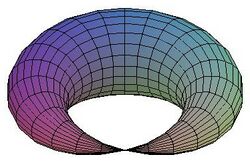Pseudomanifold
In mathematics, a pseudomanifold is a special type of topological space. It looks like a manifold at most of its points, but it may contain singularities. For example, the cone of solutions of forms a pseudomanifold.

A pseudomanifold can be regarded as a combinatorial realisation of the general idea of a manifold with singularities. The concepts of orientability, orientation and degree of a mapping make sense for pseudomanifolds and moreover, within the combinatorial approach, pseudomanifolds form the natural domain of definition for these concepts.[1][2]
Definition
A topological space X endowed with a triangulation K is an n-dimensional pseudomanifold if the following conditions hold:[3]
- (pure) X = |K| is the union of all n-simplices.
- Every (n–1)-simplex is a face of exactly one or two n-simplices for n > 1.
- For every pair of n-simplices σ and σ' in K, there is a sequence of n-simplices σ = σ0, σ1, ..., σk = σ' such that the intersection σi ∩ σi+1 is an (n−1)-simplex for all i = 0, ..., k−1.
Implications of the definition
- Condition 2 means that X is a non-branching simplicial complex.[4]
- Condition 3 means that X is a strongly connected simplicial complex.[4]
- If we require Condition 2 to hold only for (n−1)-simplexes in sequences of n-simplexes in Condition 3, we obtain an equivalent definition only for n=2. For n≥3 there are examples of combinatorial non-pseudomanifolds that are strongly connected through sequences of n-simplexes satisfying Condition 2.[5]
Decomposition
Strongly connected n-complexes can always be assembled from n-simplexes gluing just two of them at (n−1)-simplexes. However, in general, construction by gluing can lead to non-pseudomanifoldness (see Figure 2).

Nevertheless it is always possible to decompose a non-pseudomanifold surface into manifold parts cutting only at singular edges and vertices (see Figure 2 in blue). For some surfaces several non-equivalent options are possible (see Figure 3).

On the other hand, in higher dimension, for n>2, the situation becomes rather tricky.
- In general, for n≥3, n-pseudomanifolds cannot be decomposed into manifold parts only by cutting at singularities (see Figure 4).

- For n≥3, there are n-complexes that cannot be decomposed, even into pseudomanifold parts, only by cutting at singularities.[5]
Related definitions
- A pseudomanifold is called normal if the link of each simplex with codimension ≥ 2 is a pseudomanifold.
Examples
- A pinched torus (see Figure 1) is an example of an orientable, compact 2-dimensional pseudomanifold.[3]
(Note that a pinched torus is not a normal pseudomanifold, since the link of a vertex is not connected.)
- Complex algebraic varieties (even with singularities) are examples of pseudomanifolds.[4]
(Note that real algebraic varieties aren't always pseudomanifolds, since their singularities can be of codimension 1, take xy=0 for example.)
- Thom spaces of vector bundles over triangulable compact manifolds are examples of pseudomanifolds.[4]
- Triangulable, compact, connected, homology manifolds over Z are examples of pseudomanifolds.[4]
- Complexes obtained gluing two 4-simplices at a common tetrahedron are a proper superset of 4-pseudomanifolds used in spin foam formulation of loop quantum gravity.[6]
- Combinatorial n-complexes defined by gluing two n-simplexes at a (n-1)-face are not always n-pseudomanifolds. Gluing can induce non-pseudomanifoldness.[5]
See also
References
- ↑ Seifert, H.; Threlfall, W. (1980), Textbook of Topology, Academic Press Inc., ISBN 0-12-634850-2, https://archive.org/details/seifertthrelfall0000seif
- ↑ Spanier, H. (1966), Algebraic Topology, McGraw-Hill Education, ISBN 0-07-059883-5
- ↑ 3.0 3.1 Brasselet, J. P. (1996). "Intersection of Algebraic Cycles". Journal of Mathematical Sciences (Springer New York) 82 (5): 3625–3632. doi:10.1007/bf02362566.
- ↑ 4.0 4.1 4.2 4.3 4.4 Hazewinkel, Michiel, ed. (2001), "Pseudo-manifold", Encyclopedia of Mathematics, Springer Science+Business Media B.V. / Kluwer Academic Publishers, ISBN 978-1-55608-010-4, https://www.encyclopediaofmath.org/index.php?title=Main_Page
- ↑ 5.0 5.1 5.2 F. Morando. Decomposition and Modeling in the Non-Manifold domain (PhD). pp. 139–142. arXiv:1904.00306v1.
- ↑ Baez, John C; Christensen, J Daniel; Halford, Thomas R; Tsang, David C (2002-08-22). "Spin foam models of Riemannian quantum gravity". Classical and Quantum Gravity (IOP Publishing) 19 (18): 4627–4648. doi:10.1088/0264-9381/19/18/301. ISSN 0264-9381.
 |
